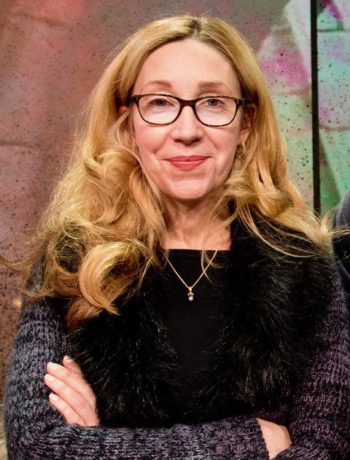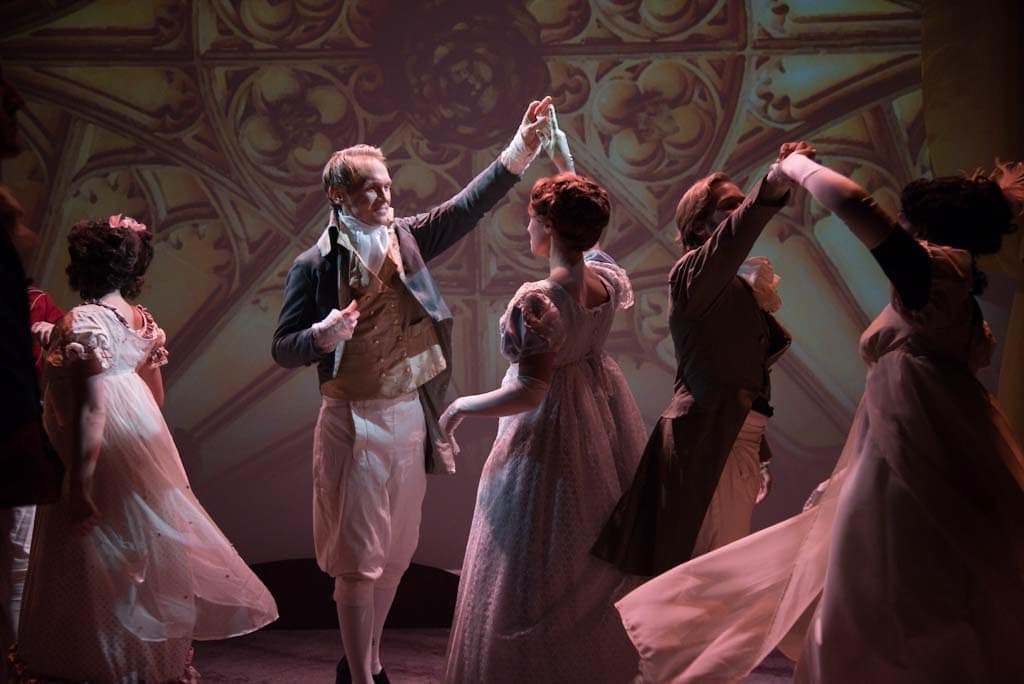Sally Boyett is the Artistic Director of Annapolis Shakespeare Company, which is making a name for itself with its clever productions of Shakespeare and the classics. She has directed many ASC shows, including Cabaret, The Comedy of Errors, and Kiss Me, Kate, as well as their current show, Pride and Prejudice, based on Jane Austen’s classic novel. She generously spoke with DC Theater Arts about Pride and Prejudice and the current season.

What made you interested in directing Pride and Prejudice?
As a lover of Jane Austen and English period drama, I wanted to put on this show. Out of all of Austen’s novels, Pride and Prejudice is probably the most well known, and the characters in this work have real depth. In one of my early talks with the actors, I said, we need to go deep with these characters. They’re facing real problems. Women didn’t have many options during this time period; there were only a few men they could marry, and the lower their class, the fewer options they had. Before Austen’s works, marriage was separate from the idea of romantic love. Marriage was a business arrangement. Pride and Prejudice is a Cinderella story, in that there are obstacles for these characters to overcome.
In addition, this adaptation by Jon Jory has a lot of movement, and as a director, I love working with movement. And having worked so much with Laura Rocklyn [playing Elizabeth Bennet], I wanted a play that would feature her.
How familiar should audience members be with the novel before seeing this production?
This play will reawaken a desire to reread the novel for those who have read it before. I’ve even heard of high school students who, having seen the play, now want to watch the movie! Ultimately, though, it stands alone, as any dramatic work has to. The novel is very narrative-driven and episodic, and we had to leave out things; it’s interesting to read the novel and see what we’ve left out. As an aficionado of 19th-century manners, we also made some changes to make the costumes and manners more accurate.
Where there any challenges in staging the show?
One major challenge was all the different locations, which means a lot of scene changes and transitions. As you know, there’s nothing worse than a clunky transition, so we keep the actors onstage during them, and they move a lot as well. Coming from my experiences as a Broadway dancer and ballerina, I’m probably the most movement-based director in the area. Longbourn, the Bennet home, is a regular location, and every time we return to it, we change the arrangement of the furniture slightly. It really goes back to Directing 101: if you’re going to have a chair onstage, you’d better use it.
Another challenge was the large cast of 14 people. During the Ball scene, we had to have everyone onstage dancing.

The play has a lot of narration and exposition, which can slow down the action. So, for example, we have the letters read by different people, and have different characters taking over the narration. We added music underneath the narration and movement throughout to keep the audience paying attention.
How did you and the cast prepare?
With every show I do, I work with the actors on movement, body alignment, and postures. If you look at clothes from this period, men’s jackets don’t have much material in the back, so their shoulders are pulled back. Women had corsets, which affected their posture too. We work on emphasizing realism in everything, especially the characters’ responses and the scale of performance. Because we’re doing classical shows in an intimate setting, everything needs to be realistic. We can’t have anyone declaiming onstage. We teach them how to walk with a 19th-century gait, and, with Voice and Dialect Coach Nancy Krebs, we train them how to speak with the proper dialect. For instance, back then, “room” was pronounced like “rum.” We train everybody so that everybody gets better.
It’s all part of filling the gaps that are in many actors’ training. Even in Masters acting programs, they don’t get much experience with classical work. All the actors we work with want to go to the next level. We’re not interested in the work we’ve already done; we’re interested in the work we’re going to do.
One advantage of being the Scenic Designer and Costume Designer, as well as the Director on this show, is that if I wanted something, it happened. There weren’t too many arguments!
Was there anything that surprised you or the cast in preparing for the play?
It’s a lot of work to successfully perform Austen’s novel, requiring a lot of attention to detail, from the costumes, the set, the manners, and dialect. Everything needs the appropriate level of detail.
The last Austen we did was Sense and Sensibility in 2015 and the last time we did Pride and Prejudice was in 2013. In that time, I had forgotten just how witty and clever Austen is. I think a lot of the actors didn’t pick up a lot of the wit until I pointed it out. My mother was from London originally, and I grew up knowing the British vernacular, so I was able to catch Austen’s humor, and make sure the actors could recognize it.
Also, there’s a lot of autobiography in Austen’s works, which I didn’t expect.
What do you hope audiences will take away from seeing Pride and Prejudice?
Other than a delightful afternoon or evening at the theater? [Laughs]. There is a bit of a lesson in the play, like “don’t judge a book by its cover,” but more importantly, I hope audiences will enjoy the romantic comedy, and see the cleverness, the wit, the humor in the play. You can get really emotionally invested in the characters, root for the couples to get together, and there’s a villain to boo. Everyone loves a Cinderella story.

I hope the play also helps to show that the classics aren’t museum pieces. There’s a universality in them that stands the test of time. The fact that there’s a Bollywood Pride and Prejudice and a zombie Pride and Prejudice proves that there’s something in the work that appeals to people, no matter what time or culture.
In addition to your mainstage shows, you put on outdoor productions at Reynolds Tavern and St. John’s College. How did that come about?
The performances at Reynolds Tavern began in 2013. The proprietor of Reynolds and I had worked together at Disney, and we wanted to do a 90-minute show out in the courtyard. We usually do a Moliere play or The Complete Works of Shakespeare Abridged. It’s a nice introduction to the classics and is less of a commitment than going to the theater. And you can get something to eat too. I like to call it “classical theater lite.”
The outdoor Shakespeare production came about because we wanted to do something for the community, a sort of “Shakespeare in the Park.” We do large-scale productions of Shakespeare plays, using the architecture of the building or the beauty of the grounds to set the scene. We started in the Carroll House grounds and now we’re doing it on the front lawn of St. John’s College.
This season offers an interesting selection of shows: The Comedy of Errors, Cabaret, Rosencrantz and Guildenstern are Dead, Pride and Prejudice, then later Oliver! Tartuffe, and The Winter’s Tale. Why did you pick these shows?
The works in this season fit the mission and vision of Annapolis Shakespeare Company, but also offers an interesting variety for audiences to enjoy. They demonstrate that there isn’t anything we can’t do. In terms of developing an audience, we’re doing work that people are going to come out to see. We can’t just do all experimental work and expect to grow our audience, so we have a wide range of work that shows the variety of what we can do.
What’s your vision for the future of Annapolis Shakespeare Company?
To be the regional destination for classics and Shakespeare in Maryland.
What drives you?
I’d say the work drives me. I couldn’t imagine doing anything other than what I am now. I was on the first national tour with Crazy for You, and the first international tour with that show, and I’ve performed at Lincoln Center. I don’t shy away from hard work. It takes a lot of stamina and commitment to build a theater from scratch, and I love doing it. Occasionally I get the chance to perform onstage, but for me it’s about the production, not being onstage. Classical theater, like classical ballet or opera, requires rigor, and that’s what drives me.
What’s your dream show?
[Laughs] I have a lot of ideas, and a lot of dream shows, but I’m finding a way to get to them, little by little.
Pride and Prejudice plays through April 21, 2019, at Annapolis Shakespeare Company – 1804 West Street in Annapolis, MD. Purchase tickets at the door, call the box office at (410) 415-3513 or go online.
[Related: Our review of ‘Pride and Prejudice’ at Annapolis Shakespeare Company]




